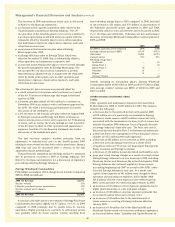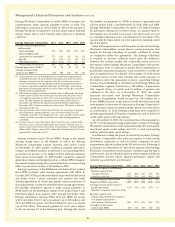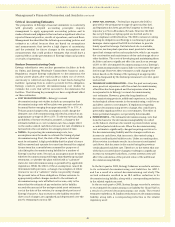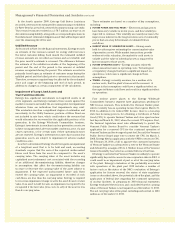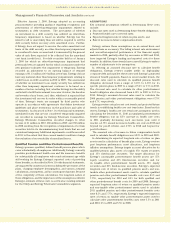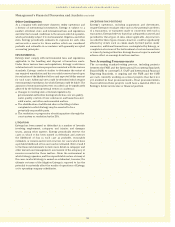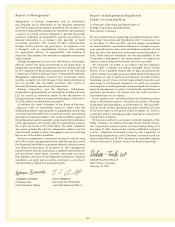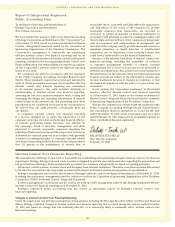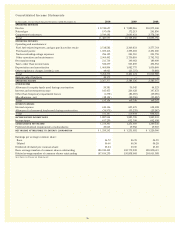Entergy 2010 Annual Report Download - page 48
Download and view the complete annual report
Please find page 48 of the 2010 Entergy annual report below. You can navigate through the pages in the report by either clicking on the pages listed below, or by using the keyword search tool below to find specific information within the annual report.
Management’s Financial Discussion and Analysis continued
LPSC and City Council Action Related to the Entergy Arkansas
and Entergy Mississippi Notices of Termination
In light of the notices of Entergy Arkansas and Entergy Mississippi
to terminate participation in the current System Agreement, in
January 2008 the LPSC unanimously voted to direct the LPSC
Staff to begin evaluating the potential for a new agreement.
Likewise, the New Orleans City Council opened a docket to
gather information on progress towards a successor agreement.
The LPSC subsequently passed a resolution stating that it cannot
evaluate successor arrangements without having certainty about
System Agreement exit obligations.
Independent Coordinator of Transmission
In 2000, the FERC issued an order encouraging utilities to
voluntarily place their transmission facilities under the control
of independent RTOs (regional transmission organizations).
Delays in implementing the FERC RTO order occurred due to
a variety of reasons, including the fact that utility companies,
other stakeholders, and federal and state regulators have had
to work to resolve various issues related to the establishment of
such RTOs.
In November 2006, after nearly a decade of effort, including
filings, orders, technical conferences, and proceedings at the
FERC, the Utility operating companies installed the Southwest
Power Pool (SPP) as their Independent Coordinator of
Transmission (ICT). The installation does not transfer control of
Entergy’s transmission system to the ICT, but rather vests with
the ICT responsibility for:
n granting or denying transmission service on the Utility
operating companies’ transmission system.
n administering the Utility operating companies’ OASIS node
for purposes of processing and evaluating transmission
service requests and ensuring compliance with the Utility
operating companies’ obligation to post transmission-related
information.
n developing a base plan for the Utility operating companies’
transmission system that will result in the ICT making the
determination on whether costs of transmission upgrades
should be rolled into the Utility operating companies’
transmission rates or directly assigned to the customer
requesting or causing an upgrade to be constructed. This
should result in a transmission pricing structure that
ensures that the Utility operating companies’ retail native
load customers are required to pay for only those upgrades
necessary to reliably serve their needs.
n serving as the reliability coordinator for the Entergy
transmission system.
n overseeing the operation of the weekly procurement
process (WPP).
n evaluating interconnection-related investments already made
on the Entergy System for purposes of determining the future
allocation of the uncredited portion of these investments,
pursuant to a detailed methodology. The ICT agreement also
clarifies the rights that customers receive when they fund a
supplemental upgrade.
In October 2008 the FERC issued an order accepting a tariff
amendment establishing that the WPP shall take effect at a date to
be determined, after completion of successful simulation trials and
the ICT’s endorsement of the WPP’s implementation. On January
16, 2009, the Utility operating companies filed a compliance filing
with the FERC that included the ICT’s endorsement of the WPP
implementation, subject to the FERC’s acceptance of certain
additional tariff amendments and the completion of simulation
testing and certain other items. The Utility operating companies
filed the tariff amendments supported by the ICT on the same day.
The amendments proposed to further amend the WPP to (a) limit
supplier offers in the WPP to on-peak periods and (b) eliminate
the granting of certain transmission service through the WPP.
On March 17, 2009, the FERC issued an order conditionally
approving the proposed modification to the WPP to allow
the process to be implemented the week of March 23, 2009.
In its order approving the requested modifications, the FERC
imposed additional conditions related to the ICT arrangement
and indicated it was going to evaluate the success of the ICT
arrangement, including the cost and benefits of implementing
the WPP and whether the WPP goes far enough to address
the transmission access issues that the ICT and WPP were
intended to address. The FERC, in conjunction with the APSC,
the LPSC, the MPSC, the PUCT, and the City Council, hosted a
conference on June 24, 2009, to discuss the ICT arrangement
and transmission access on the Entergy transmission system. In
compliance with the FERC’s March 2009 order, in November 2009
the Utility operating companies filed with the FERC a process for
evaluating the modification or replacement of the current ICT and
WPP arrangements.
During the conference, several issues were raised by regulators
and market participants, including the adequacy of the Utility
operating companies’ capital investment in the transmission
system, the Utility operating companies’ compliance with the
existing North American Electric Reliability Corporation (NERC)
reliability planning standards, the availability of transmission
service across the system, and whether the Utility operating
companies could have purchased lower cost power from
merchant generators located on the transmission system rather
than running their older generating facilities. On July 20, 2009,
the Utility operating companies filed comments with the FERC
responding to the issues raised during the conference. The
comments explain that: 1) the Utility operating companies believe
that the ICT arrangement has fulfilled its objectives; 2) the Utility
operating companies’ transmission planning practices comply
with laws and regulations regarding the planning and operation
of the transmission system; and 3) these planning practices have
resulted in a system that meets applicable reliability standards
and is sufficiently robust to allow the Utility operating companies
both to substantially increase the amount of transmission service
available to third parties and to make significant amounts of
economic purchases from the wholesale market for the benefit
of the Utility operating companies’ retail customers. The Utility
operating companies also explain that, as with other transmission
systems, there are certain times during which congestion occurs
on the Utility operating companies’ transmission system that
limits the ability of the Utility operating companies as well as other
parties to fully utilize the generating resources that have been
granted transmission service. Additionally, the Utility operating
companies commit in their response to exploring and working
on potential reforms or alternatives for the ICT arrangement that
could take effect following the initial term. The Utility operating
companies’ comments also recognize that NERC is in the process
of amending certain of its transmission reliability planning
standards and that the amended standards, if approved by the
FERC, will result in more stringent transmission planning criteria
being applicable in the future. The FERC may also make other
changes to transmission reliability standards. These changes
46


